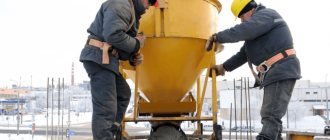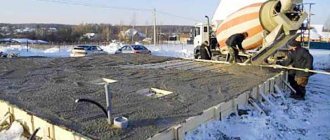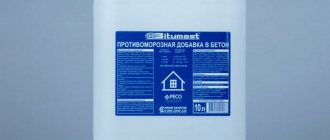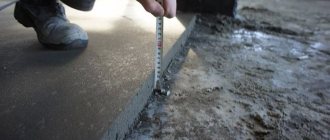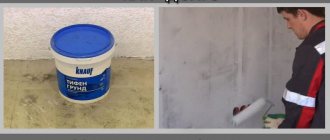Home |Construction |Bricklaying at sub-zero temperatures
Date: November 14, 2017
Comments: 0
Brick is a traditional building material used in the construction industry. It is used for the construction of residential buildings and industrial facilities. Work on the construction of brick walls is carried out throughout the year, regardless of changing weather conditions. However, bricklaying in winter has its own characteristics associated with performing work in winter. The main problem in this case is the slowdown in cement hydration and changes in the properties of the solution during the cold season. Let's consider what methods can be used to overcome these problems.
How long does it take for brickwork to dry outside and at what temperature can it be laid?
Usually all construction work is carried out in warm weather and for good reason.
This is due to the peculiarities of the hardening of the solution and the complexity of the work being carried out. After all, not everyone is able to dig frozen soil for a foundation trench, and water freezes in the cold. And this component of construction mixtures, in particular, it is part of the cement mortar. Due to a number of difficulties, rarely does anyone decide to build housing at sub-zero temperatures. But, if the construction of a facility inevitably needs to be carried out in winter, then this is doable. You just need to adhere to certain rules and know the nuances of hardening the solution at different temperatures.
Reinforcement of cinder block walls.
Reinforcement is used to distribute loads, increase the stability of walls and reduce the risk of cracks in cinder block masonry.
For reinforcement the following are used:
- reinforcement, the rods of which are placed in grooves on a layer of mortar and covered with mortar on top;
- metal mesh for masonry with a cell of 50x50 mm, which is covered with a layer of mortar to prevent rusting;
- reinforcement frames made of paired galvanized steel strips connected by wire, laid on a layer of glue or mortar.
The first row of blocks is reinforced without fail, then every four rows. In the case of wall openings, reinforcement is required on both sides.
Optimal temperature for work
To ensure the best quality of masonry, all work should be carried out in warm weather. In this case, the air temperature can fluctuate from 10°C to 25°C, and humidity - up to 75%. Such conditions allow you to create a durable and high-quality structure. The decrease in temperature is directly related to the deterioration of the hardening of the solution . Temperatures below 0°C will cause water, which is a component of the composition, to freeze. At the same time, adhesion to brick and the quality of masonry will deteriorate.
If setting occurs before the temperature drops and the solution holds the masonry, it may not harden due to freezing of the water. At sub-zero temperatures it loses the following qualities:
- elasticity;
- density of filling joints between bricks;
- strength - this characteristic does not return even with the establishment of a positive temperature and hardening of the solution.
The hardening time of the cement mixture at low temperatures increases by 4 times. If negative, the solution simply freezes. As soon as the air temperature begins to rise, the composition defrosts, but then it loses some of its basic properties. Brickwork made in winter conditions will differ in strength from summer. When planning to lay bricks in winter, it is worth considering the following construction features:
- the water in the solution is converted into ice, which leads to an increase in volume by about 10%; upon thawing it decreases;
- it is difficult to maintain the strength characteristics of the masonry;
- instability of temperatures in winter can lead to the formation of cracks throughout the structure due to voids appearing in the solution;
- Frost may form on the brick.
Properties of the solution
In addition to various methods, chemical additives are also required. Basically these are special anti-cold products.
During construction, special nests are created in the seams, plugged with plugs, and temperature measurements are constantly taken. It should be taken into account that a brick, for example, is solid, conducts cold quite slowly, so there is time for the mortar to set.
While the exothermic reaction is taking place, adding heat, the solution is “pressed” by the brick from below and above.
As a result, we obtain a table in which the temperature of the solution corresponds to the air measurement indicators.
- 5 degrees - minus 10 degrees;
- 10 degrees – minus 10-20 degrees;
- 15 degrees – minus 20 degrees.
Optimal temperature
Air humidity up to 75% and positive temperature from 10–25 0 C are the determining factors for high-quality bricklaying.
As the temperature drops to below zero, the rate of hardening of the cement mortar slows down. And at low temperatures it does not harden at all due to the formation of ice in the cement mixture.
If cement mortar was used on the eve of frost and the brickwork holds, this does not mean that the mortar has hardened. It most likely lost its normal elasticity due to ice forming in it, resulting in a poor seal between the bricks. After thawing and hardening of the mortar, the strength of the brickwork decreases noticeably.
The hardening time of the solution at low positive temperatures increases 4 times. When negative, the solution sets and freezes.
But as the temperature rises, the defrosting process affects the quality and strength of the mixture. Complete restoration of the qualities of the solution after freezing can only occur with a very slow increase in temperature over the course of a week.
Its performance will be much worse compared to summer masonry, but the strength will not be restored to its original levels.
Masonry at low temperatures
Work in winter is caused by some difficulties, directly related to the temperature effect on the water in the cement mortar.
Therefore, it is necessary to take into account the following features of winter masonry:
- The formation of ice in the solution increases its volume by 10%. When defrosting, the volume returns to its original value.
- It is quite difficult to achieve the required masonry strength.
- Uneven temperature readings in winter can lead to the formation of voids in the mixture and cracks throughout the structure.
- Frost formation on bricks.
In this regard, it is necessary to adjust the composition and components of the cement mortar for low and negative temperatures as follows:
- In frosty weather, add detergent or liquid soap to the solution, while reducing the amount of water.
- Rapid freezing is prevented by a plasticizer - an anti-frost additive used even when laying down to -20 0 C. Follow the temperature tolerances and indications of the additive manufacturer, which are indicated on the back.
- The mobility of the mixture varies from 10–13 cm along the cone.
- For good masonry it is necessary to use a plastic mortar.
- After installation, periodically monitor the temperature of the solution. To do this, make a small depression in the masonry for the thermometer.
Approximate cost of laying cinder block.
The cost of buildings made from cinder blocks is usually low. The price of one block ranges from 25–45 rubles, depending on the quality and the seller. The best option is to purchase cinder blocks directly from the manufacturer, especially since many of them offer free shipping.
Construction crews set an average price for laying cinder blocks at 20 rubles per unit. The choice of teams is very large; when choosing, one should proceed from their prices and examples of work performed.
If you decide to do the masonry with your own hands, in addition to knowing the general technology of the process, you will also need to study many nuances.
Brickwork in winter - technology features and heating methods
When performing winter masonry, you must adhere to the following technological recommendations:
- erect walls around the perimeter of the building, maintaining the general level;
- make a shrinkage seam at the border of the work area;
- install reinforced concrete reinforcement elements in the area of window openings;
- ensure the immobility of the formwork in the area of the openings using wedges;
- maintain a stable thickness of seams in the horizontal and vertical plane;
- fill vertical joints with cement when work is temporarily stopped;
- protect unfinished masonry from moisture using sheets of roofing material;
- remove frozen mortar, snow and ice when resuming bricklaying;
- Monitor compliance with the verticality of the erected walls when performing work.
Compliance with these requirements will ensure the strength of brick walls.
In addition to anti-frost additives, plasticizers are used when laying bricks in winter.
In order to ensure favorable conditions when performing construction work on the construction of walls, various methods are used:
- heating plant device. This method involves the construction of a temporary frame structure made of wood or metal. It protects the work area from precipitation and is covered with film or tarpaulin. A heating device is installed inside to maintain favorable conditions. Heaters powered by gasoline, diesel or electric power, as well as those powered by wood, are used. This is a costly method, since the temperature must be maintained throughout the entire hardening period;
- electric heating with electrodes. To implement the method, you need a step-down transformer and experience in working with electricity. Electric heating is effective in limited areas. It is carried out by installing rod electrodes made of steel reinforcement. They are introduced with a binding solution at intervals of no more than half a meter and connected to a source of voltage reduced to 60 V. Such heating accelerates hydration at a significant cost of electricity.
The determination of the optimal method for carrying out construction activities is made taking into account the specific conditions of the construction site and an assessment of the overall level of costs associated with the increased need for energy resources.
Attaching the Mauerlat to the cinder block.
When making a roof, you need to pay special attention to its fastening - otherwise the first gust of wind will leave you without it. This is why you need a mauerlat - a wooden beam laid around the perimeter of the walls to evenly distribute the load from the roof.
To attach the Mauerlat to the cinder blocks, first make a monolithic reinforced concrete screed. Having secured the wooden formwork to the walls, concrete is poured and before it sets, metal pins are inserted.
The Mauerlat itself is laid no earlier than three days after this. Having previously laid roofing material around the perimeter of the roof, the beams are drilled and secured to the wall with washers on studs and nuts.
General recommendations
Many people mistakenly believe that it is impossible to work with bricks in frosty weather, since masonry requires an exclusively positive temperature regime. Allegedly, at low temperatures, the masonry mortar changes its characteristics, its hardness decreases, which negatively affects the stability of the element being built.
It is fair to note that bricklaying in winter is possible if special construction techniques are used.
These include:
- slowing down the hardening of the masonry mass;
- crystallization of the water in which the solution is mixed;
- maintaining the elasticity of the sand-cement mixture, facilitating the sealing of joints;
- maintaining the strength indicator at the proper level.
Practical advice
For those who don’t know at what temperature it is possible to lay brickwork outside, experts still advise using summer time as much as possible. The fact is that construction in winter reduces the quality of the masonry, and financial costs increase by about thirty percent.
Before laying bricks in the cold with the addition of anti-frost additives to the masonry mixture, purchase cement material M 300 for preparing the mortar. It will improve the technical parameters of hardening.
If the construction of premises is underway, the operation of which is planned in conditions of high humidity, adding PMD to the mortar mass is strictly prohibited, since the sand-cement mixture will lose its strength.
The thickness of the mortar joint can be maintained at no more than twelve millimeters. Otherwise, during the thawing process, the solution will behave unpredictably, violating the integrity of the masonry.
Is it possible to build a brick house in winter? Yes, only the speed of laying brick stones should exceed the operating mode for the summer season.
In the event of a break in work and frosty weather, when resuming masonry, it is necessary to warm up the upper brick rows using a construction hair dryer. To save time on heating, it is recommended to insulate the laid rows after finishing work.
Is it possible to do masonry when the air temperature drops below twenty degrees below zero? Remember that for such temperature conditions it is best to pause the masonry process.
When performing work using the freezing method, you should not skimp on reinforcement. It is recommended to install reinforced concrete elements over window and door openings.
When carrying out masonry work in winter, special attention is paid to controlling the position of rows vertically and horizontally.
Average price on the market
Prices for cinder blocks depend on the quality of the material, dimensions, solid or hollow, as well as functional purpose.
Average prices for cinder blocks:
- broken block, 650 rub./m3;
- decorative, 2180 rub./m3;
- facing, 2760 rub./m3;
- partition, 2395 rub./m3;
- full-bodied, 2690 rub./m3;
- hollow, 2300 rub./m3
- color block, 1620 rub/m3;
- 100*200*400, 1850 rub./m3;
- 200x300x600, 1750 rub./m3;
- 390x190x190, 1695 rub./m3;
- 400x200x200, 2250 rub./m3;
- M-100, 2093 rub./m3.
Read more about the cost of blocks and construction costs here.
Electric heating
The essence of the electric heating method is to attach sewn-on electrodes on the side of the outer wall. An electric current is passed through the cement mortar, thereby heating it.
When the building mixture warms up, the brick receives heat, resulting in a warm island being formed on the wall. Thus, without changing the physical properties of the solution, the masonry gradually hardens.
Advice! When it is necessary to use electric current during construction, it is important not only to provide insulation, but also to have a heated base.
Pros and cons of houses
In order for the cinder block to fully display all its positive characteristics, it will be necessary to correctly select the material according to its functional purpose and carry out the installation technology.
The main advantages of cinder blocks:
good thermal protection performance for hollow models;- low prices for wall material;
- simple masonry;
- low specific consumption of masonry adhesive;
- high frost resistance if the walls are waterproofed;
- high strength and fire resistance characteristics.
This wall material also has quite a few disadvantages that can be leveled out with the correct masonry technology.
Developers include the following disadvantages::
- increased hygroscopicity, requires reliable waterproofing;
- low sound protection, eliminated by an external thermal protection system made of mineral wool or basalt wool;
- low thermal protection for solid blocks;
- complexity of performing engineering inputs;
- low environmental safety of slag from blast furnace production.
More information here.
What should the foundation be?
Before laying cinder block walls, the developer must choose the type of foundation for this wall material. This is the most important stage, since the reliability and long-term operation of the house will depend on it.
Basic points influencing the choice of foundation:
- soil type;
- climatic and seismological characteristics of the construction area;
- number of storeys of the house and, accordingly, the total load on the foundation;
- depth of freezing and occurrence of groundwater.
For cinder block houses, it is allowed to install foundations of pile, slab, strip and column types. The final decision is applied during a technical and economic comparison of several options when executing a construction project.
When is dismantling necessary?
In the case when, during the construction of cinder block walls, the material was selected incorrectly, the laying technology was violated, for example, waterproofing and thermal protection were not performed, such structures can quickly become unusable. It is quite possible that the way out of this situation will be to dismantle the wall.
Despite their low strength, cinder block walls can be dismantled with a regular sledgehammer . Therefore, for dismantling there is no need to use powerful specialized equipment.
Before starting to dismantle a cinder block wall, study its functional purpose. It is not allowed to disassemble load-bearing walls without a design, and the design must include locations and reinforcement technology.
Before starting work, the dismantling work area is marked, and the cinder blocks are slowly broken with a hammer drill, while the process proceeds from top to bottom. The main negative features of this method are the high cost of work and loud noise during disassembly.
Dismantling begins after holes are drilled along the marking line with a tool, at an equal distance from each other. After that, a piece of jewelry is knocked out of the wall with a sledgehammer so that it does not fall on the floor. In this way, you can dismantle the wall yourself.
Cost of work
Unit prices for wall dismantling:
- partitions 200 mm, 680 rub./m2;
- internal wall 350 mm, 1800 rub./m2;
- dismantling the window sill 350 mm, 2500 rub./m2.



